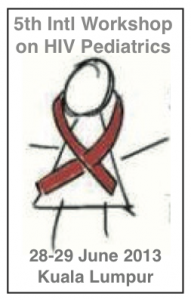Decreased growth in ART exposed uninfected infants in Botswana
25 July 2013. Related: Conference reports, Antiretrovirals, Pregnancy, Paediatric care, Paediatric Workshop 5 Kuala Lumpur 2013.
 Polly Clayden, HIV i-Base
Polly Clayden, HIV i-Base
In utero ART exposure is associated with significantly lower weight and length at 24 months of life in HIV-exposed uninfected infants compared to those with AZT exposure.
Poor growth has been reported in HIV-exposed uninfected infants exposed to ART in utero compared to AZT but this phenomenon has not been looked at longer term.
Kate Powis presented data from a comparison of uninfected, breast fed infants participating in clinical trials in Botswana to find out if in utero exposure to AZT vs ART results in different growth outcomes.
The Mashi and Mma Bana studies enrolled HIV positive pregnant women from the same four sites. In both trials infant weight and length measurements were routinely taken until 24 months of age.
The analysis included singleton infants born at term to mothers receiving ART or AZT for at least two weeks before delivery, breastfed and remaining HIV negative at 18 to 24 months with weight/length measurements at 24 months.
Infants/children were measured a birth, monthly through 6 months and every 3 months starting at 9 months to 24 months of age. Weight-for-age (WAZ), length- for-age (LAZ), and weight-for-length (WLZ) z- scores were derived from WHO Child Growth Standards. WAZ, LAZ and WLZ were compared by antiretroviral exposure at 24 months using t-test and linear regression.
Data for 513 ART exposed and 3003 AZT exposed children were included in the analysis. Median maternal CD4 count at enrollment was 392 and 324 cells/mm3 in mothers receiving AZT and ART respectively, p<0.001. Median duration of infant in utero exposure to AZT or ART was 5.7 weeks and 12.0 weeks respectively, p<0.001; mean months breastfed was 5.1 and 5.2, respectively, p= 0.41; and mean birth weight was 3.16 kg and 3.04 kg respectively, p<001.
In unadjusted analysis, at 24 months, mean WAZ and LAZ were significantly lower in ART exposed infants while mean WLZ did not differ significantly: WAZ -0.51 (95% CI -0.61 to -0.42) vs -0.28 (95% CI -0.40 to -0.17), p=0.002; LAZ -1.00 (95% CI -1.11 to -0.90) vs -0.71 (95% CI -0.89 to -0.61), p=0.001 and WLZ -0.02 (95% CI -0.11 to +0.08) vs +0.09 (95% CI -0.05 to +0.23), p=0.21.
In multivariate analysis, adjusted for maternal CD4, viral load enrollment site, in utero ARV exposure duration and maternal BMI at 1-month postpartum, in utero ART exposure remained significantly associated with lower mean LAZ, effect estimate AZT vs ART +0.54 (95% CI +0.28 to +0.80), and WAZ, +0.41(95%CI +0.19 to +0.63), p<0.003.
By sex, the weight and height differential for girls were +0.61 kg, p=0.01, and +2.11 cm, p<0.001, and for boys +0.48, p=0.02 and +1.35 cm, p=0.02.
Dr Powis suggested that study limitations were differences between cohorts in timing of maternal ARV initiation by gestational age and Mashi infants received twice daily AZT thoughout breastfeeding while Mma Bana infants were exposed to maternal ART through breast feeding. There was also no control group of HIV-unexposed infants.
Reference:
Powis K et al. In utero HAART exposure associated with decreased growth among HIV-exposed uninfected breast fed infants in Botswana. 5th International Workshop on HIV Pediatrics. 28 – 29 June 2013, Kuala Lumpur, Malaysia. Late breaker oral abstract. O_11.
http://regist2.virology-education.com/2013/5hivped/docs/22_Powis.pdf (PDF slides)
This study was also presented as a poster at the 7th IAS Conference on HIV Pathogenesis, Treatment and Prevention, 30 June – 3 July 2013, Kuala Lumpur. Poster available.
http://pag.ias2013.org/abstracts.aspx?aid=1113

